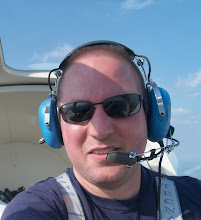Looking at my logbook I discovered that I had not flown the Tecnam Sierra low wing since December 3, 2008, and that was only for a hour. I wanted to test my skill and become reacquainted with the airplane at the same time. I got my instructor and told him that I wanted to do engine out emergency procedures during our flight. We agreed to go over to Ridgely where we thought the traffic pattern would be much less crowded. The flight over was fun and uneventful. Once in the area of Ridgely we discovered that there were ultralights and hang gliders in the pattern. We set up for left traffic on runway 30. Once I was on the downwind leg my instructor said "pull the power." I throttled back to idle power and the airplane began to slow. The object of this game was simple: use the energy you have available to get the airplane from 1000 ft agl on the downwind leg to the runway threshold and a landing. At idle power the airplane will descend but not at a constant rate. There is a speed where the airplane will descend at the slowest rate and cover the most ground while it does it. That is called "best glide speed." While the aircraft engine is running you control your altitude with your throttle and your speed with your pitch. Yes, you are reading it correctly. Without getting into a long winded explanation about it, your pitch attitude will control your speed. At idle power the aircraft will be descending and you can control your forward airspeed by your pitch control. If you pitch the airplane down your forward speed will increase and so will your descent rate. Pitching back will decrease your forward airspeed and your descent rate until you get to best glide speed for the airplane. Pitching back for a speed slower that the best glide rate will increase you rate of descent until you reach your aerodynamic stall speed at which point you have slowed to the point where the wings will no longer produce enough lift to allow you to continue to fly.
A normal traffic landing pattern consists of 90 degree turns to the left on each phase of the pattern.

The emergency landing pattern is really just a long 180 degree turn from the downwind leg. Now the fun part is the timing. This changes depending on wind direction. You want to be able to time you turns and your distance from the runway so that once you are lined up on a final approach you can glide just over the numbers and land. When it works it's a thing of beauty. We performed about four of these and with the Sierra's ability to glide they turned out to be somewhat of a non-event. Nevertheless the experience was very valuable and confidence building.


No comments:
Post a Comment